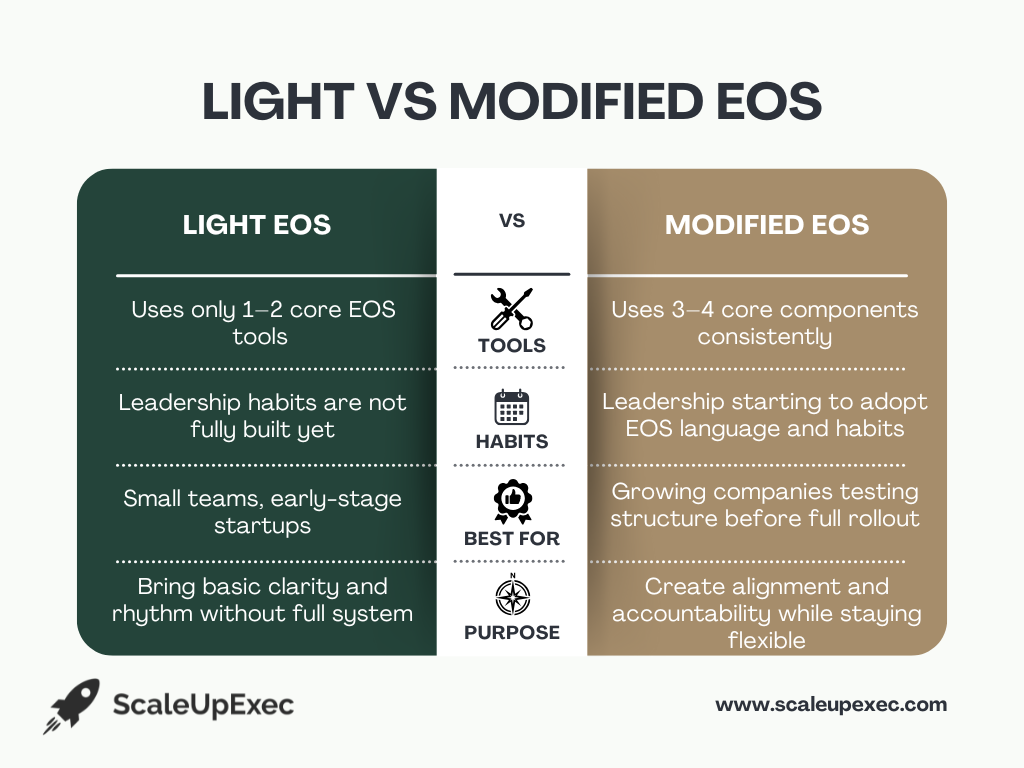EOS stands for the “Entrepreneurial Operating System”. It’s a business framework designed to help leadership teams stay focused, organized, and accountable. It gives growing companies a simple set of tools to manage people, set goals, and track progress.
When people talk about “EOS in business,” they’re usually referring to how a company uses this system to run its day-to-day operations. But not every business uses EOS in the same way. There are different types or approaches, depending on the company’s size, stage, and leadership style.
Some businesses go all-in on EOS with full leadership buy-in. Others use parts of the system, like Rocks or Scorecards, to improve clarity and focus. In both cases, EOS brings structure that helps teams grow with less stress.
Full EOS Implementation
Full EOS implementation means a company is using all six key components of the system: Vision, People, Data, Issues, Process, and Traction. The leadership team meets weekly for Level 10 Meetings, tracks performance using Scorecards, and sets quarterly Rocks.
This approach often involves working with a certified EOS Implementer during the first few months. They guide the company through the tools and help the team develop strong EOS habits.

Many businesses combine EOS with outsourced COO services for growth. These companies use part-time or fractional leaders to keep EOS running smoothly without hiring full-time executives.
Light EOS or Modified EOS
Some companies don’t follow EOS by the book, but they still use its core tools. They might run Level 10 Meetings or use Rocks, but skip certain parts of the process. This is known as “light” or “modified” EOS.

This version works best for smaller teams or companies that are still figuring out their leadership structure. It allows flexibility while still bringing order to the business.
In some cases, leadership teams start with a few tools and grow into a full EOS model over time. Helping startups scale with a fractional COO becomes much easier when EOS tools are already in place, even in a lighter form.
EOS with a Visionary and Integrator Model
EOS encourages a specific leadership structure: the Visionary and the Integrator. The Visionary focuses on big-picture ideas, culture, and innovation. The Integrator focuses on execution, systems, and accountability.
Some companies follow this model closely, with both roles clearly defined. Others combine the two roles or leave one unfilled. This often depends on the size of the business and how much leadership capacity is available.
For early-stage companies, it’s not always practical to hire a full-time Integrator. That’s why many founders consider hiring a fractional COO before Series A. A fractional COO can step into the Integrator role and help lead the team through the EOS process.
EOS with a Fractional Team
More and more companies are blending EOS with fractional leadership. Instead of hiring a full executive team, they bring in part-time leaders, such as COOs, CFOs, or CMOs, to guide strategy and execution.
This is especially useful for startups that need strong operations but aren’t ready to invest in full-time leadership. A fractional COO can take ownership of the EOS process, drive execution, and build strong habits across the team.
When deciding between a fractional COO vs EOS Integrator, it’s important to understand the difference. A fractional COO brings both strategy and execution, often across multiple areas of the business. An Integrator focuses specifically on making EOS run well inside the company.
When to Use EOS in a Business
EOS is best for companies that are growing quickly but feel disorganized. If the leadership team struggles to stay aligned or make decisions, EOS adds structure. If the business has hit a ceiling, EOS helps break through it.
It’s also a great fit for founders who want to step out of day-to-day operations. With the right structure, they can focus on vision while their Integrator or COO keeps the business running.
Companies preparing for funding often start EOS early to build better habits. Hiring a fractional COO gives investors confidence that the business can scale with systems in place.
How EOS Adapts to Different Businesses

Every company is different. That’s why EOS can be flexible. Some teams follow the system exactly, while others use it as a base and adjust along the way. The key is consistency: using the tools weekly, tracking what matters, and staying accountable.
Smaller teams may only need a few tools to create big change. Larger companies may need a full rollout with leadership support and coaching. In both cases, EOS gives structure that helps the business grow.
Pairing EOS with outsourced COO service ensures there’s someone steering the ship and keeping meetings on track, solving problems, and driving progress every week.
Final Thoughts
There’s no one way to “run on EOS.” Some businesses use the full system with trained Implementers. Others start small and grow into it. What matters most is that the tools work and that someone is responsible for making sure they’re used.
Whether it’s a full-time Integrator, a founder, or a fractional leader, someone has to lead the process. Understanding the differences between a fractional COO vs EOS Integrator helps companies choose the right support for their size and goals.
EOS is not just a set of tools; it’s a way to bring clarity, direction, and accountability to your business. And when combined with the right operational support, it becomes a powerful system for growth.
At ScaleUpExec, we don’t just help you run on EOS; we adapt it to your business with seasoned COOs who have scaled companies from startup through exit. Most SMBs can’t access this level of leadership full time, but with us you get it at a fraction of the cost, ensuring EOS actually delivers growth. Contact us today to see how we can tailor EOS for your company.







